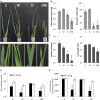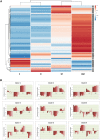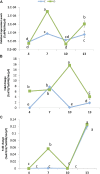Dehydration Stress Contributes to the Enhancement of Plant Defense Response and Mite Performance on Barley
- PMID: 29681917
- PMCID: PMC5898276
- DOI: 10.3389/fpls.2018.00458
Dehydration Stress Contributes to the Enhancement of Plant Defense Response and Mite Performance on Barley
Abstract
Under natural conditions, plants suffer different stresses simultaneously or in a sequential way. At present, the combined effect of biotic and abiotic stressors is one of the most important threats to crop production. Understanding how plants deal with the panoply of potential stresses affecting them is crucial to develop biotechnological tools to protect plants. As well as for drought stress, the economic importance of the spider mite on agriculture is expected to increase due to climate change. Barley is a host of the polyphagous spider mite Tetranychus urticae and drought produces important yield losses. To obtain insights on the combined effect of drought and mite stresses on the defensive response of this cereal, we have analyzed the transcriptomic responses of barley plants subjected to dehydration (water-deficit) treatment, spider mite attack, or to the combined dehydration-spider mite stress. The expression patterns of mite-induced responsive genes included many jasmonic acid responsive genes and were quickly induced. In contrast, genes related to dehydration tolerance were later up-regulated. Besides, a higher up-regulation of mite-induced defenses was showed by the combined dehydration and mite treatment than by the individual mite stress. On the other hand, the performance of the mite in dehydration stressed and well-watered plants was tested. Despite the stronger defensive response in plants that suffer dehydration and mite stresses, the spider mite demonstrates a better performance under dehydration condition than in well-watered plants. These results highlight the complexity of the regulatory events leading to the response to a combination of stresses and emphasize the difficulties to predict their consequences on crop production.
Keywords: Hordeum vulgare; Tetranychus urticae; dehydration stress; differential gene expression; plant-biotic-abiotic interaction.
Figures







References
LinkOut - more resources
Full Text Sources
Other Literature Sources
Research Materials

